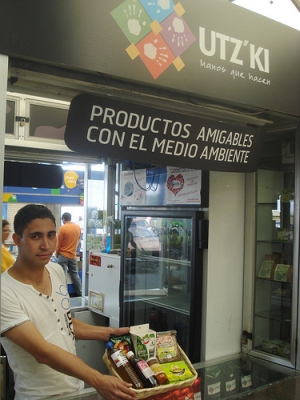Central America Looks to Sustainable Development

Central America, a narrow tropical isthmus flanked by the Pacific Ocean and the Caribbean Sea, suffered 259 extreme weather-related events between 1930 and 2009, while the cumulative effects of innumerable smaller-scale events have not even been recorded.
These disasters have increased in frequency by five percent a year over the past three decades, according to the Economic Commission for Latin America and the Caribbean (ECLAC).
The regional economy itself, based on monoculture and dependent on fossil fuels, exacerbates the problem.
Hit hard by drought, floods and hurricanes, which have worsened with global warming, the seven countries of Central America, with their combined population of 47 million people, have been forced to try something different and are turning towards sustainable development.
'We have a saw mill, an agroforestry plantation, and are developing productive projects like fish farming and the raising of egg-laying chickens,' Nubia Sosa, manager of the Integral Forestry Association of San Andrés Petén in northern Guatemala, told IPS.
Since 1999, the association has had a concession from the government’s National Council of Protected Areas to manage some 52,000 hectares of forest in the Maya Biosphere, where its members have been able to make a sustainable living.
'It is very important to have alternatives that combine both economic and environmental aspects,' Sosa said. Her association won the 2011 Sasakawa Prize awarded by the United Nations Environment Programme (UNEP) to initiatives that conserve biodiversity while fighting poverty.
Central America and the rest of the countries bathed by the Caribbean Sea share a natural vulnerability, which has been aggravated by climate change. The last natural disaster to hit the region was tropical depression 12E, which affected some 2.6 million people in Costa Rica, El Salvador, Guatemala, Honduras and Nicaragua in October 2011.
Infrastructure and crop losses amounted to nearly two billion dollars, according to ECLAC.
And the region had not yet even recovered from the devastation caused by hurricanes Mitch in 1998, Stan in 2005, and Agatha in 2010. In addition, it was hit by heavy drought in 2009, especially Nicaragua, Honduras, El Salvador and Guatemala.
The scarcity and high prices of grains and vegetables, the damages to infrastructure and the productive sector, and soaring prices for oil imports have forced the region to begin to look into sustainable alternatives.
'To cope with this global crisis, it is essential to integrate responsible economic development, environmentally-friendly practices by farmers and businesses, and the use of cleaner, eco-efficient tools of production,' Mauricio Chacón, with the Sustainable Economic Development Programme in Central America, told IPS.
This initiative, financed by the state-owned German Agency for Technical Cooperation (GTZ), has drawn up a Central American catalogue of 'green businesses' that will be placed on-line to provide companies with information on new markets, business opportunities, credit and other aspects.
These businesses are an important source of environmentally-friendly production in industries like organic food, renewable energy and sustainable tourism, Chacón said.
One of the fastest-growing areas is renewable energies, with a variety of wind, solar and hydropower projects launched by alliances between the public and private sectors and international donors.
In Guatemala, for example, the Central American Bank for Economic Integration signed a contract with a private bank in February to administer a 30 million dollar line of credit to finance projects to develop and generate renewable energies.
At a regional level, the countries have also implemented initiatives to protect agricultural production, such as the Regional Programme of Research and Innovation for Value Chains, which is working on the production of tomatoes, manioc, potatoes and avocados.
The aim is to boost availability of foodstuffs, which have been hit hard by weather events and aggravated because the diet in rural areas, where poverty is concentrated, is based on monoculture corn production.
The programme is carried out by the Inter-American Institute for Cooperation in Agriculture (IICA) and financed with 7.6 million dollars from the European Union.
Mario Ardón with the non-governmental Association of Advisers for Sustainable, Ecological and Humane Agriculture told IPS that if the region does not seek alternative forms of production, the future will be one of 'social, economic and food crises.'
With respect to the impact of climate change, the outlook is anything but promising for Central America.
If greenhouse gas emissions continue to increase at the current rate, the accumulated cost of global warming from here to 2100 could reach 73 billion dollars, equivalent to 54 percent of the region’s combined GDP for 2008, according to the report Economics of Climate Change in Latin America and the Caribbean, published by ECLAC in late 2010.
In that scenario, the temperature would rise between 3.6 and 4.7 degrees, depending on the country, with an average decline in rainfall of 28 percent.
'For that reason, our strategy is focused on small-holder family farming, in order to produce food year-round, make use of biomass, and preserve moisture in the soil, all of which makes it the key alternative with respect to climate change,' Ardón said.
Big business is also taking part in the effort.
Daniel García with Guatemala’s Chamber of Industry told IPS that they are working in two phases: achieving compliance with environmental and energy efficiency standards and working on a policy of cleaner production.
The business sector is also exploring the field of renewable energy, 'to make industries more competitive and less dependent on fossil fuels,' he said.
'We are very dependent on our traditional energy sources and monoculture farming, but we have to take measures to fight climate change,' he said.
© Inter Press Service (2012) — All Rights ReservedOriginal source: Inter Press Service
 Global Issues
Global Issues